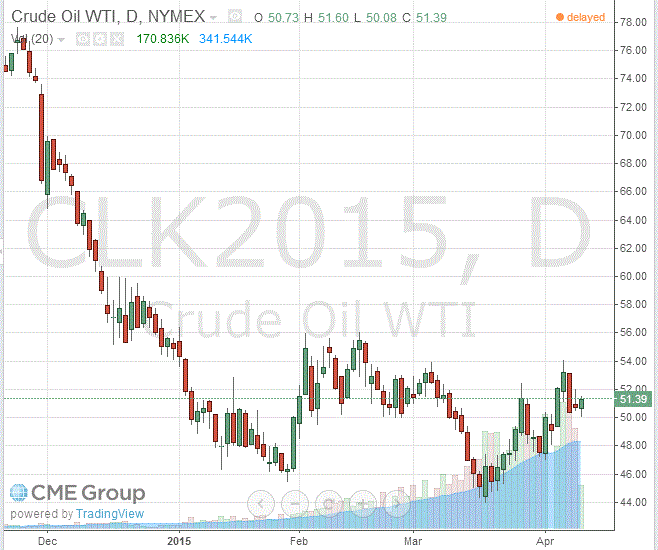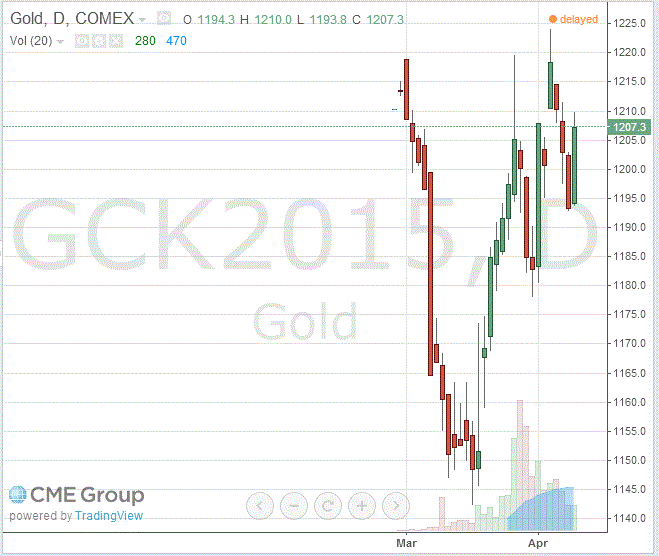Noticias del mercado
-
17:40
Oil: а review of the market situation
Oil prices rose moderately, entrenched above $ 57 (Brent) and $ 51 (WTI), which is associated with the weakening of concerns about the fact that the Interim Agreement on Iran's nuclear program will lead to a rapid increase in oil supplies.
Recall, Iran's Supreme Leader Ali Khamenei demanded that all sanctions against his country were canceled on the same day is reached final agreement on Iran's nuclear program, but the United States is planning a gradual easing of sanctions. "If an agreement is reached and then will not soon, so Iranian oil will return to the market is not as fast as we expected two weeks ago," - said the chief strategist at CMC Markets Michael McCarthy.
Meanwhile, Commerzbank analyst Eugen Weinberg said: "If judged solely on the price of oil, the market is not convinced that the deal with Iran will be held, and its exports will recover. If Iran is not ready to negotiate without the lifting of sanctions, there will be no agreement ". It should be emphasized, according to brokers and officials from Iran holds 7 million to 35 million barrels of oil in storage to direct them for export, as soon as the nuclear deal will be concluded.
Support prices also have recent statements Saudi Oil Minister Ali al-Naimi. He said that the kingdom is ready to increase oil prices. But only if the same thing will make the rest of the exporting country. "The Kingdom is ready to bring stability to the market and increase the price of oil, but on condition of participation in the major exporting countries and importers, as well as under the condition that it will be based on clear principles and have a high level of transparency" - said al-Naimi .
Pressure oil continues to report the US government, which showed that crude oil inventories rose by nearly 11 million barrels last week, registering the biggest gain in 14 years.
May futures for US light crude oil WTI (Light Sweet Crude Oil) rose to 51.39 dollars per barrel on the New York Mercantile Exchange.
May futures price for North Sea petroleum mix of Brent increased by $ 0.78 to 57.58 dollars a barrel on the London Stock Exchange ICE Futures Europe.
-
17:20
Gold: а review of the market situation
The value of gold has increased significantly, again overcome the level of $ 1200, which was due to a fall in bond yields after the publication of weak US data.
US Department of Labor said: prices of imported goods fell last month, indicating that the weak global economy and the actions of foreign central banks to keep inflation in the United States. According to the data, import prices fell 0.3% in March from February. Prices fell in eight of the last nine months and were lower by 10.5% compared to last year. Economists had expected a 0.4% monthly drop in import prices. Weak import prices have contributed to the long period of low inflation in the United States. They largely reflect weak demand from foreign economies, especially in Europe and Asia, which prevented companies get more value for their products. But the latter also reflects the weakness of efforts to promote global central banks, which effectively weaken their currency against the US dollar. Strengthening of the dollar actually makes foreign goods cheaper in the world market. Export prices in the United States, meanwhile, rose 0.1% in March from February. It was the first increase since July.
Price increases also helps change investor sentiment and expectations of interest rate hikes in the United States. "What is changing quickly, so it is investors' expectations' 'said the expert Wing Fung Financial Group brands viz. According to him, the variability of investor sentiment associated with the approach of June - the expected date of the first interest rate increase in the United States.
Meanwhile, according to analysts GFMS, this year gold could drop to five-year low of $ 1,100 due to a better state of the US economy compared to Europe and developing countries.
As for the situation in the physical market, the demand in Asia this week was low, and the Shanghai Gold Exchange precious metals offered for $ 02.01 per ounce more global standard.
May futures for gold on the COMEX today rose to 1207.30 dollars per ounce.
-
12:20
Oil: prices moderately lower at the end of the week
Oil is trading moderately lower today. Brent Crude lost -0.11% currently trading at USD56.51 a barrel. On January 13th Crude set a low at USD45.19. West Texas Intermediate declined by -0.73% currently quoted at USD50.42. Yesterday oil recovered from Wednesday's big slump caused by higher U.S. stockpiles and news that Saudi Arabia increased oil production.In the week 28 March to 3 April oil reserves increased by 10.9 million barrels to 482.4 million barrels, while experts waited for an increase of 3.4 million barrels. The report also reported that weekly growth of oil reserves was the most significant since March 2001.
Today Baker Hughes Rig Count data will be in the focus. Active drilling rigs almost halved in 12 months. Still, U.S. output did not decline.
-
12:00
Gold recovers after four days of losses
Gold is trading higher at the end of the week, back over the USD 1,200 level, after retreating for four days in a row. The minutes of the last FOMC policy meeting showed that the board is divided on whether to hike interest rates in June or not. As a consequence of the weaker-than-expected GDP growth and disappointing labour market data a potential interest rate hike might be delayed till September. But speculations for a midyear rate hike by the FED - despite weaker economic data coming from the U.S. - weighed on the precious metal. According to FED Governor Powell the FED could hike interest rates as early as June if labor markets data remains strong and points to a recovery.
A stronger US dollar is putting pressure on gold, as it reduces the metal's appeal as an alternative asset and makes dollar-denominated commodities more expensive for holders of other currencies.
Gold is currently quoted at USD1,202.40 +0,72% a troy ounce, back above the USD1,200 level. On Thursday the 22nd of January gold reached a five-month high at USD1,307.40. On Tuesday the 17th of march gold traded as low as USD1,142.50, a three-month low.
-
10:20
Press Review: BOJ's Nakaso warns market against betting on more easing
BLOOMBERG
We Traveled Across China and Returned Terrified for the Economy
China's steel and metals markets, a barometer of the world's second-biggest economy, are "a lot worse than you think," according to a Bloomberg Intelligence analyst who just completed a tour of the country.
What he saw: idle cranes, empty construction sites and half-finished, abandoned buildings in several cities. Conversations with executives reinforced the "gloomy" outlook.
"China's metals demand is plummeting," wrote Kenneth Hoffman, the metals analyst who spent a week traveling across the country, meeting with executives, traders, industry groups and analysts. "Demand is rapidly deteriorating as the government slows its infrastructure building and transforms into a consumer economy."
REUTERS
Exclusive - BOJ's Nakaso warns market against betting on more easing
(Reuters) - Bank of Japan Deputy Governor Hiroshi Nakaso has tempered market expectations that the bank will expand its stimulus program later this month, saying a cut in its inflation forecast would not be enough to justify more monetary easing.
Nakaso, one of Governor Haruhiko Kuroda's two deputies, said that while slumping oil costs have pushed inflation back to zero, rising wages and a steady economic recovery will underpin a long-term rise in prices.
"What's important is the underlying trend of inflation dynamics, which are steadily improving," Nakaso told Reuters in an interview on Thursday, his first with non-Japanese media in nearly a year.
Source: http://www.reuters.com/article/2015/04/10/us-japan-economy-boj-idUSKBN0N10KX20150410
BLOOMBERG
Putin's Surprising New Ruble Problem Threatens Russian Coffers
Vladimir Putin is facing a problem few could have anticipated: The ruble is becoming too strong.
Last year's worst-performing major currency is this year's best and while that's buoying the nation's bonds, driving yields to the lowest in four months, it's also crimping Russia's export revenue. Even though oil is little changed in dollars this year, the price when converted to rubles has plunged to the lowest since 2011.
The currency rout in 2014 helped Russia to keep its budget deficit within 1 percent of gross domestic product as the ruble weakened in lockstep with a 50 percent slump in oil. Now, with the cease-fire in Ukraine and the allure of higher-yielding assets attracting investors to ruble debt, the government is seeing the opposite effect.
-
00:33
Commodities. Daily history for Apr 9’2015:
(raw materials / closing price /% change)
Oil 50.79 +0.73%
Gold 1,194.10 +0.04%
-

